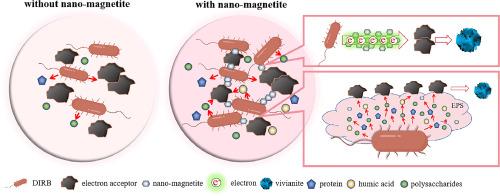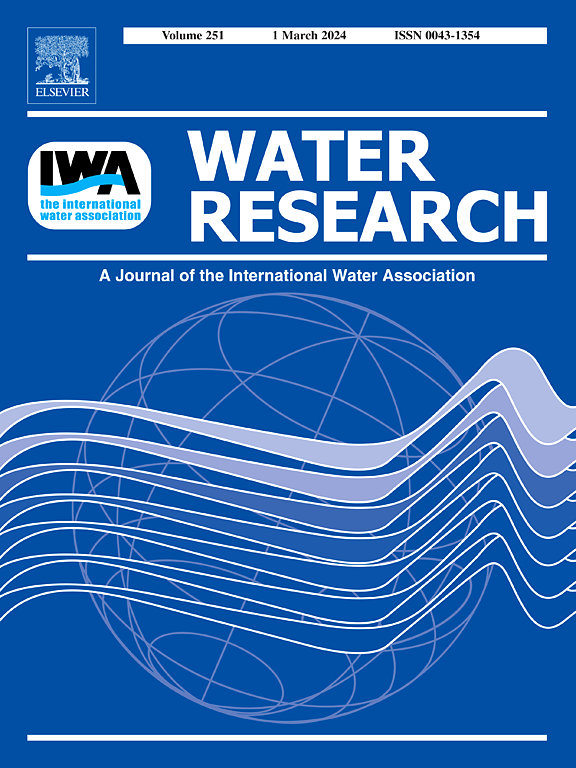Nano-magnetite enhances dissimilated iron reduction to vivianite from sewage by structuring an enormous and compact electron transfer network
IF 11.4
1区 环境科学与生态学
Q1 ENGINEERING, ENVIRONMENTAL
引用次数: 0
Abstract
Acting as both terminal and conductor of extracellular electron transfer (EET), little studies were focused on how nano-magnetite participated in the dissimilated iron reduction (DIR), especially the synthesis of vivianite, which was the typical DIR products from sewage. In this study, nano-magnetite was confirmed to enhance DIR of ferrihydrite and akaganeite for vivianite recovery from sewage. Nano-magnetite incorporation enriched Comamonas and Geobacter in sewage, and microbial protein content was increased by 123% and 57% in ferrihydrite and akaganeite batches, respectively. In Geobacter sulfurreducens PCA pure culture, vivianite yield was promoted by 21% and 37% in ferrihydrite and akaganeite batches in the presence of nano-magnetite, respectively. Due to its nanoscale size and superior electrical conductivity, nano-magnetite embedded in the gaps formed by the microorganisms and electron acceptor, and architected coherent conductive pathways to promote EET. Simultaneously, the addition of nano-magnetite stimulated the secretion of proteins, polysaccharides, and humic acids in the extracellular polymeric substances. Nano-magnetite addition structured an enormous and compact electron transfer network, thus enhanced DIR and vivianite formation. Our study proposed a new strategy to promote iron-reduction-coupled phosphorus recovery with natural DIR products, and provided theoretical support for clarifying the interaction between minerals and microorganisms.

纳米磁铁矿通过构建一个巨大而紧凑的电子传递网络,促进污水中的溶解铁还原成维维安石
纳米磁铁矿既是细胞外电子传递(EET)的终端,又是其导体,但人们很少关注纳米磁铁矿如何参与异化铁还原(DIR),尤其是污水中典型的 DIR 产物 vivianite 的合成。在这项研究中,纳米磁铁矿被证实可提高铁水铁和赤铁矿的 DIR,从而从污水中回收 vivianite。纳米磁铁矿的加入富集了污水中的 Comamonas 和 Geobacter,在铁水石和赤铁矿批次中,微生物蛋白质含量分别增加了 123% 和 57%。在 Geobacter sulfurreducens PCA 纯培养物中,在纳米磁铁矿存在的情况下,铁矾土和赤铁矿批次的 vivianite 产量分别提高了 21% 和 37%。纳米磁铁矿具有纳米级尺寸和优异的导电性,可嵌入微生物和电子受体形成的间隙中,并形成连贯的导电路径,从而促进 EET。同时,纳米磁铁矿的加入还刺激了细胞外聚合物质中蛋白质、多糖和腐殖酸的分泌。纳米磁铁矿的加入构建了一个巨大而紧凑的电子传递网络,从而促进了 DIR 和 vivianite 的形成。我们的研究提出了一种利用天然 DIR 产品促进铁还原耦合磷回收的新策略,并为阐明矿物质与微生物之间的相互作用提供了理论支持。
本文章由计算机程序翻译,如有差异,请以英文原文为准。
求助全文
约1分钟内获得全文
求助全文
来源期刊

Water Research
环境科学-工程:环境
CiteScore
20.80
自引率
9.40%
发文量
1307
审稿时长
38 days
期刊介绍:
Water Research, along with its open access companion journal Water Research X, serves as a platform for publishing original research papers covering various aspects of the science and technology related to the anthropogenic water cycle, water quality, and its management worldwide. The audience targeted by the journal comprises biologists, chemical engineers, chemists, civil engineers, environmental engineers, limnologists, and microbiologists. The scope of the journal include:
•Treatment processes for water and wastewaters (municipal, agricultural, industrial, and on-site treatment), including resource recovery and residuals management;
•Urban hydrology including sewer systems, stormwater management, and green infrastructure;
•Drinking water treatment and distribution;
•Potable and non-potable water reuse;
•Sanitation, public health, and risk assessment;
•Anaerobic digestion, solid and hazardous waste management, including source characterization and the effects and control of leachates and gaseous emissions;
•Contaminants (chemical, microbial, anthropogenic particles such as nanoparticles or microplastics) and related water quality sensing, monitoring, fate, and assessment;
•Anthropogenic impacts on inland, tidal, coastal and urban waters, focusing on surface and ground waters, and point and non-point sources of pollution;
•Environmental restoration, linked to surface water, groundwater and groundwater remediation;
•Analysis of the interfaces between sediments and water, and between water and atmosphere, focusing specifically on anthropogenic impacts;
•Mathematical modelling, systems analysis, machine learning, and beneficial use of big data related to the anthropogenic water cycle;
•Socio-economic, policy, and regulations studies.
 求助内容:
求助内容: 应助结果提醒方式:
应助结果提醒方式:


